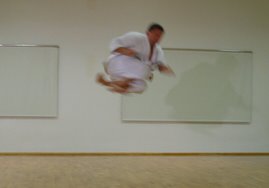A technical piece on stances in karate that i wrote a couple of years ago:
---------------------------
Stances.
General.
Stances are a very important subject to study carefully so as to fully understand your martial arts training. They are the foundation to our techniques, they facilitate movement, changes the distance to the opponent and also strengthens the leg-muscles to minimize the risk of injury.
--------
How-to technical points.
Always have your spine straight and the hips level. Your karate-movement should not deviate from how the body naturally is designed to move. Remember never to let your behind stick out or lean backwards (thus compromising your posture). Do not let your knees be twisted in a different direction than your toes (if this is not observed rigidly, then the risk of injury is very high)
For beginners this way of moving is perceived as rigid and unnatural, but this is usually due to lack of muscle-control and also over-complicating the process.
---------
Overview of basic stances.
Zenkutsu dachi
Great for projecting power forwards. Shoulder-width to allow for the smooth use of hiprotation and about two shoulderwidths long. Front toes turned slightly inward to promote firmness in the structure of the stance (makes it more natural to engage the inner thigh-muscles) The toes of the back foot should ideally point in the same direction as the front foot. If this is difficult to achieve due to lack of mobility in the ankle then make a shorter stance. (The free operation of the hip is more important than the extremely long and low stance sometimes seen in non-japanese karateka) To make sure that stance-stability is maintained, dont let either knee travel sideways at any point while using this stance. (This is also very important to minimise the risk of debilitating injury)
Kokutsu dachi.
Slightly shorter than zenkutsu. Front toes pointing straight forward, back toes at a 90 degree angle and the feet in a straight line towards your opponent. Bending the knees exactly the same way as your toes again is of utmost concern. Front knee bent slightly, back knee bent as much as possible while maintaining a straight posture and level hips. This stance is very useful to train body-shifting away from the opponent and also leads to ease of counter-kicking with the front foot.
Kibadachi.
Double shoulder-width, toes slightly inwards, drop weight as far as possible, as long as you are able to maintain your hips under your shoulders. Make sure knees are in the same direction as the toes. Beginners usually have their knees too far inside and needs to concentrate on pushing them out a little bit. However, not to the point of the stance becoming like "square-ish" as this again is an un-natural way of moving.
----------
General afterthoughts.
In my opinion basic stances are for training the body and to develop good habits that will make your karate efficient against an opponent and injuryfree for you so that you can train karate even into your senior years.
Rigid observation of stance in kihon and kata is of great importance for training, but this should be understood that is for health and for the muscles to remember the principles of correct movement.
For application in kumite or selfdefence a more freeflowing stance is desirable (heels may float and the rigid observation of form is of little value)
Einar-08



No comments:
Post a Comment